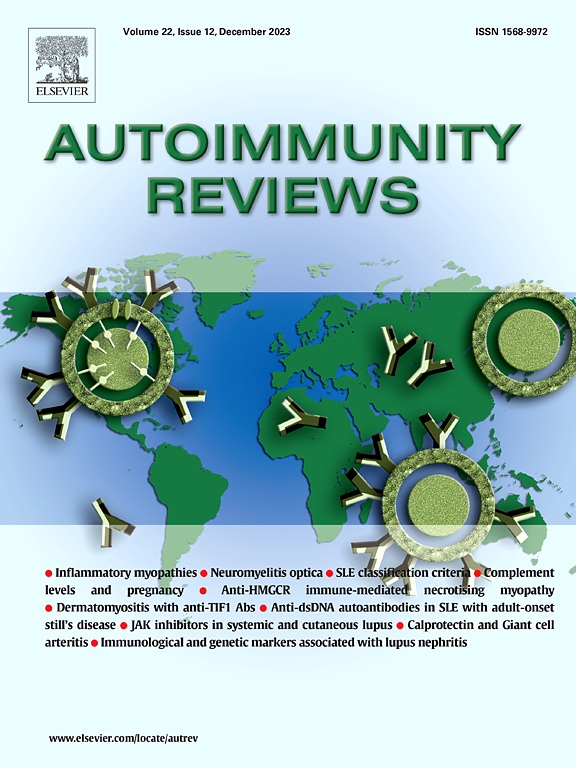Assessment and management for latent tuberculosis before advanced therapies for immune-mediated inflammatory diseases: A comprehensive review
IF 9.2
1区 医学
Q1 IMMUNOLOGY
引用次数: 0
Abstract
Tuberculosis (TB), caused by Mycobacterium tuberculosis , is the most significant infectious cause of mortality across the globe. While TB disease can prey on immunocompetent individuals, it is more likely to occur in immunocompromised individuals. Immune-mediated inflammatory diseases (IMIDs) are a group of diseases (rheumatoid arthritis, inflammatory bowel disease, ankylosing spondylitis, psoriasis, hidradenitis suppurativa, autoimmune blistering diseases, and others) where there may be a need for systemic immunosuppression to control the disease manifestations, treat symptoms and improve long term outcomes. Immunosuppression may predispose them to active TB either from recent infection or reactivation of Latent TB (LTB). The major determinants of reactivation include the type of therapy (highest risk with TNF inhibitors and JAK inhibitors) and the underlying TB endemicity. The strategy to avoid TB reactivation includes the detection of LTB using tests that detect immunoreactivity to TB antigens (interferon-gamma release assays or tuberculin skin test) and treating LTB before or with initiation of IMID therapies. Available diagnostic tests have deficiencies in diagnostic sensitivity to detect LTB and even worse capability in predicting reactivation of TB. In addition to immunological tests, more stringent testing strategy utilizing one or many LTB equivalents may point towards subclinical TB. LTB equivalents include clinical (past history of TB, recent exposure to TB) and radiological criteria (use of chest roentgenogram, computed tomography, or, sometimes positron emission tomography – computed tomography). The present review summarizes the risk factors for TB reactivation in patients initiated on advanced therapies, geographically appropriate strategies for LTB testing, and treatment of LTB.
免疫介导的炎症性疾病先进治疗前潜伏性结核病的评估和管理:综述
由结核分枝杆菌引起的结核病是全球最重要的致死传染病。虽然结核病可以侵袭免疫正常的个体,但它更有可能发生在免疫功能低下的个体中。免疫介导的炎症性疾病(IMIDs)是一类疾病(类风湿关节炎、炎症性肠病、强直性脊柱炎、牛皮癣、化脓性汗腺炎、自身免疫性水疱疾病等),可能需要全身免疫抑制来控制疾病表现、治疗症状和改善长期预后。免疫抑制可能使他们因最近感染或潜伏性结核(LTB)的再激活而易患活动性结核。再激活的主要决定因素包括治疗类型(TNF抑制剂和JAK抑制剂的风险最高)和潜在的结核病地方性。避免结核再激活的策略包括使用检测结核抗原免疫反应性的试验(干扰素- γ释放试验或结核菌素皮肤试验)检测结核分枝杆菌,并在开始IMID治疗之前或同时治疗结核分枝杆菌。现有的诊断测试在检测LTB的诊断敏感性方面存在缺陷,在预测结核病再激活方面的能力甚至更差。除了免疫测试外,采用一种或多种LTB等效物的更严格的策略可能指向亚临床结核病。LTB等效标准包括临床(结核病病史,最近接触结核病)和放射学标准(使用胸部x线摄影,计算机断层扫描,或有时使用正电子发射断层扫描-计算机断层扫描)。本综述总结了在接受先进治疗的患者中结核病再激活的危险因素,LTB检测的地理适宜策略以及LTB的治疗。
本文章由计算机程序翻译,如有差异,请以英文原文为准。
求助全文
约1分钟内获得全文
求助全文
来源期刊

Autoimmunity reviews
医学-免疫学
CiteScore
24.70
自引率
4.40%
发文量
164
审稿时长
21 days
期刊介绍:
Autoimmunity Reviews is a publication that features up-to-date, structured reviews on various topics in the field of autoimmunity. These reviews are written by renowned experts and include demonstrative illustrations and tables. Each article will have a clear "take-home" message for readers.
The selection of articles is primarily done by the Editors-in-Chief, based on recommendations from the international Editorial Board. The topics covered in the articles span all areas of autoimmunology, aiming to bridge the gap between basic and clinical sciences.
In terms of content, the contributions in basic sciences delve into the pathophysiology and mechanisms of autoimmune disorders, as well as genomics and proteomics. On the other hand, clinical contributions focus on diseases related to autoimmunity, novel therapies, and clinical associations.
Autoimmunity Reviews is internationally recognized, and its articles are indexed and abstracted in prestigious databases such as PubMed/Medline, Science Citation Index Expanded, Biosciences Information Services, and Chemical Abstracts.
 求助内容:
求助内容: 应助结果提醒方式:
应助结果提醒方式:


